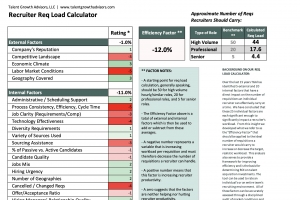Passive Candidate Sourcing: Which Technology, and Other Key Questions to Ask

Often times, we don’t dedicate the appropriate amount of time to the critical conversations up front to enhance our success during an implementation. Technology is a tool, but it, alone, will not fix your problems. Many times technology is not implemented properly to support the organization's goals or strategy and it adds to the organizational challenges.
In our two-part series entitled “How to Rock A Passive Sourcing Strategy,” we taught you how to get started passively sourcing candidates and how to differentiate your processes to do it effectively. In this article, we will discuss conversations that need to be conducted to drive implementation decisions. As mentioned above, if the proper steps are not taken prior to implementation, the system will not stand a chance of supporting your needs.
Critical Conversations to have prior to implementation?
A major pitfall for most organizations is they expect the CRM (Customer Relationship Management) to fix all their problems. However, if they haven’t identified the true problems, the implementations will not be effective and will ultimately disappoint.
What are the key roles we should source for?
Every company has critical roles that are hard to fill but are frequently open. These are the types of roles you want to source passive candidates for. When a position comes available, you should have a candidate ready to go. Sometimes these roles are obvious to the organization's services, but often times they are not. An example of this is: Accountants know to apply at McGladrey, a top public accounting firm, but may not know accounting opportunities that exist at a commercial real estate company. We also see companies that struggle to fill their obvious positions because the talent is minimal and truly hard to find. The main point here is, identify for your organization what those critical roles are. By determining these roles early, the type of candidate you need to hire will drive the experience you design for them.
Who are the right resources to do this type of work and what is the allocation needed?
Passive candidate sourcing is an investment and the overall process should be well thought out. Allocating the proper resources to do this kind of work is critical. Unfortunately, a lot of companies do not differentiate this role from the recruiting role and assign a percentage of the work to an already understaffed team. The challenge this creates is the recruiter sources 10% of the time, but when work gets more hectic sourcing is what is eliminated and the leads dry up. Depending on the number of critical roles you define, you may want to allocate a couple of resources full time to sourcing. The skill is very different than recruiting and could excite some of your current employees. The benefit of having dedicated staff for sourcing is they become the expert in the specialty—thereby strengthening the relationship with the business, build a solid network, minimize internal duplication, can build appropriate touch points and a strong relationship with the candidate, and appropriately utilize the technology. The other piece of this is to determine when the handoff should occur between the sourcer and the recruiter. It needs to be seamless for the candidate and the remainder of the candidate experience needs to be as easy as the initial relationship. For further information on how to do this, reference the previous article titled “Kim Article 2)
What is the experience we want to create for these candidates?
The best candidates have multiple companies pursuing them and they will compare the experience at all of them. You need to provide the best experience. Technology needs to be designed to support the experience you want to create and make the life of the sourcer easier. CRMs allow you to automate this in many ways, for example through automated email cadences and scheduled trigger events. Let’s say Candidate Kim told you in a conversation that she is going to Chicago next week for her birthday. You can write an email to wish her a happy birthday and schedule the day for it to be delivered ahead of time. This makes Kim feel very special and will up your chances in her willingness to learn about your opportunity. If you design the desired experience up front, it is much easier to build that experience into the technology during implementation.
Will this technology support these goals?
Now that we have created a plan, we can start to think about how we want to build the technology to support our strategy. The discussions above will drive the workflow design, the user needs, the trigger events, necessary portals, etc. By having these conversations early on, you will make sure the technology supports your strategy and not the other way around. It is never good to have a strategy built off the technology's functionality. Keeping your expectations realistic and having the critical conversation up front will ensure a strong successful relationship with whichever vendor you choose to work with.
By having these critical conversations up front, you will guarantee a great implementation that will support your team effectively.
Share this Article
Learn more about our unique approach to Talent Strategy Formulation.



